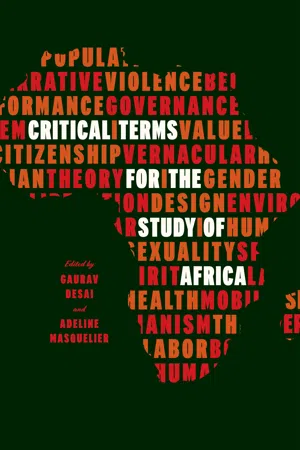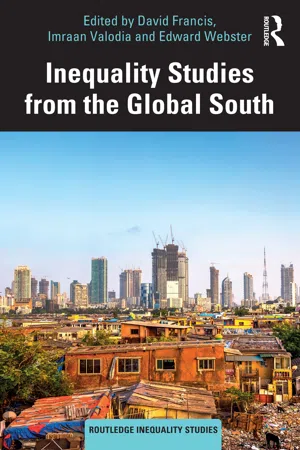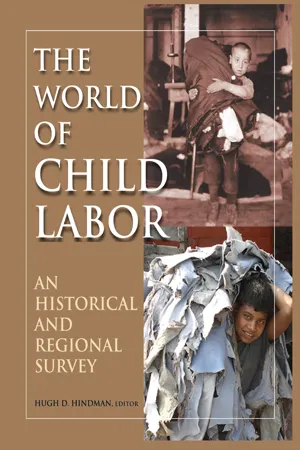History
Labor Systems in Africa
Labor systems in Africa historically encompassed a variety of arrangements, including kin-based labor, slavery, and tribute labor. These systems were shaped by factors such as social organization, economic needs, and interactions with external forces. The impact of these labor systems on African societies and their long-term legacies are subjects of ongoing scholarly inquiry.
Written by Perlego with AI-assistance
Related key terms
Related key terms
1 of 4
Related key terms
1 of 3
5 Key excerpts on "Labor Systems in Africa"
- eBook - ePub
- Gaurav Desai, Adeline Masquelier, Gaurav Desai, Adeline Masquelier(Authors)
- 2018(Publication Date)
- University of Chicago Press(Publisher)
work in English is important to pay attention to, since it carries political and analytical implications that are particularly relevant when examining closely their application outside Europe, across different languages, and under rapidly changing political-economic conditions, as in the colonial and postcolonial worlds. How did these conceptual shifts apply to African economic change?The Literature on Labor and Work
The most voluminous literature that deploys the concept of labor in African studies is historical, since it is concerned with the colonial project of creating a labor force from a population of independent producers and traders. Critical social historical scholarship would refer to the West’s gains as extractive processes that used outright violence or colonial domination to establish inferior status and thereby a nonmarket, or only partially market-governed, process of value creation. The foothold of capitalism in Africa has a specific history: the purchase and sale of people themselves as commodities, as slaves; the acquisition of land mainly by conquest or states’ rights, without purchase, including for highly profitable mineral extraction; a long colonial history of forced recruitment for large public projects; the recruitment of African men into proletarian status in essential sectors such as plantations and ports (Cooper 1980; 1996); the intricate, racially discriminatory legal regimes for the supply of labor to large businesses, such as the mines, in Southern Africa (Murray 1981). - eBook - ePub
Africapitalism
Sustainable Business and Development in Africa
- Uwafiokun Idemudia, Kenneth Amaeshi, Uwafiokun Idemudia, Kenneth Amaeshi(Authors)
- 2019(Publication Date)
- Routledge(Publisher)
While work organisation and labour institutions seek to ensure that labour practices are transparent and fair, the informal sector in Africa appears to be excluded from much of this. The Africapitalism management philosophy can contribute to outlining how work can be organised in the informal sector, how the formal sector and informal sectors might not only learn from one another but seek to form strong cooperative alliances in local supply chains and in this way try to ensure there is a sense of balance in how new forms of work organisation and institutions are structured.Research agenda item 4: Standardising and legitimising labour market institutions
There is recognition in some African countries of the conflicts of interest and common objectives of employers and employees, recognising the role of legislation in regulating inherent conflicts of interest. Labour institutions also provide a means to formalise mutual rights and obligations and inherent conflict through collective bargaining rights, conflict resolution mechanisms such as mediation, arbitration and labour courts. However, national governments in Africa are not equally effective in applying the law. In some instances employment law is widely disregarded (Wood & Horwitz, 2015; North, 1990; Horwitz, 2014; Klerck, 2014; Maree, 2014; Myant, 2014). In Eastern and Southern Africa, European colonialism saw more attention devoted to replicating their own institutional arrangements. Hence, certain colonies, ‘mini-Europes’, developed more sophisticated institutions (Robinson, 2002). However, employment rights in practice may be weaker than formal legal arrangements suggest. Nigeria and Kenya have created a ‘business friendly’ regulative environment by reducing legal restrictions and red tape (The Economist, 2013, p. 13) which may enable firms to use labour more flexibly, and/or ignore minimum employment standards, using insecure, precarious employment rather than higher value-added management models (Standing, 2001).In contrast, institutional theory suggests that meaningful compromises are possible between employers and labour that may result in beneficial outcomes for both. Institutions have complex and varied effects that mediate the nature of social relations between key social actors (DiMaggio & Powell, 1983; Hancke, Rhodes & Thatcher, 2007; North, 1990). In our analysis above, Africapitalism is not positioned as an institution but rather as a lens for understanding the influence or impact of institutions on the world of work in an African context. This is because the legal basis of institutions is not easily changed, and legislation may constrain or dilute some of the possibilities of the Africapitalism management philosophy to actualise change in how work is organised. However, these parameters are relevant to the debate on business, legal institutions and civil society actors such as employees and communities, especially considering the dual labour markets of formal (protected, regulated ‘typical’) work and informal (unregulated, atypical) work in most African political economies (Allan, Brosnan, Horwitz & Walsh, 2001; Fashoyin, 2008; Kamoche, Chizema, Mellahi & Newenham-Kahindi, 2012; Kaplinsky, McCormack & Morris, 2007). This awareness and sympathy with the dualities in Africa presents a role for the Africapitalism management philosophy, particularly with its sense of parity, referred to by Amaeshi and Idemudia (2015), which seeks to provide inclusiveness. - eBook - ePub
- David Francis, Imraan Valodia, Edward Webster(Authors)
- 2020(Publication Date)
- Routledge(Publisher)
Over the last 40 years, industry has shifted from high-income to developing countries, which now produce more than a third of global production. Africa’s share of global manufacturing fell from about 3 per cent in 1970 to less than 2 per cent in 2010; today it has much lower shares of manufacturing output per person than the average for all developing countries (Newman et al., 2016). When labour began to move out of agriculture after 2000, it mainly moved to retail trade, instead of to manufacturing. Many countries in Africa began to experience positive per capita income growth in 1995, which accelerated in the 2000s. However, despite this positive movement, African industry is now not competing with high-wage industrial production in the North, as it had been during the initial post-independence phase, but with lower-waged Asia. Further, the years of slow growth and austerity created growing gaps in infrastructure, institutions and education relative to the Asian competition, and “two decades of piecemeal reforms have not succeeded in pushing a single low-income African country over the threshold above which industrial growth becomes – as it has been in Vietnam – explosive” (Newman et al., 2016: viii). The result of the ways in which colonial powers shaped national administrations and economies, as well as the policies of the structural adjustment years is economies with small middle-class elites, is a large difference between these elites and the majority of the population. Education systems mirror this gulf.Labour market structures
The three countries in my study have small numbers of people in jobs that might generally be seen as middle-class6 and huge numbers of people either in survivalist work or unemployed. This is common in sub-Saharan Africa, where in general less than 10 per cent of the workforce is absorbed in the formal/modern sector, of which about half tends to be in the public sector (Fredriksen and Fossberg, 2014). South Africa has a larger formal sector, which includes many in precarious or low-wage work, as well as extremely high levels of unemployment instead of informal employment.Education systems reflect this labour market structure. In all three countries there is a steep drop-off from close to (or over) 100 per cent enrolment in primary education to relatively low levels of secondary completion, with South Africa having the highest, followed by Ghana, and then Ethiopia.7 - eBook - ePub
The World of Child Labor
An Historical and Regional Survey
- Hugh D Hindman, Hugh Hindman(Authors)
- 2014(Publication Date)
- Routledge(Publisher)
Children are seen as social insurance against future uncertainty, especially in the context of subsistence food production under a feudalist mode of social organization. This, therefore, forms the contextual basis of the historical analysis of the trajectory of child labor in Nigeria. It explains the lack of cultural revulsion and consequent historical pervasiveness of child labor in the precolonial Nigeria political economy all through the colonial and postcolonial dependent capitalist political economies.Dimensions of Child Labor: A Historical Reconstruction
The idea of child labor in Nigeria is a contemporary one. In fact, most Nigerians still consider advocacy against child labor as a sort of colonial mentality. Two factors can be said to be accountable for this situation. Work occupies a central position in Nigerian culture. The Yoruba say, “Ise ni ogun ise,” that is, “Hard work is the only antidote for poverty,” and also, “Ise kii pa niyan,” meaning “Hard work does not kill.” A collectivist orientation, occupational training for skill acquisition, and socialization of children into the culture of responsible citizenry, sense of community, and obedience and respect were culturally at the core of children’s involvement in work in traditional Nigerian societies. For these reasons, Oloko (2003 ) argued that exclusion of children from work was not in the interests of society, as it portends negative and dysfunctional implications for the integration of children.Child labor in Nigeria has its own unique and particularistic geography. Certain forms of child labor are predominant in certain geographical locations in the country, in tandem with the specific fauna, occupational imperatives, and cultural or religious orientations of those areas. In this regard, while cattle rearing and Almajeria child labor were specific to northern Nigeria, child pawning and bonded labor were found more in eastern and western regions. These geographical typologies of child labor are not to be taken as rigid and specific characteristics of particular geographical locations to the total exclusion of other areas. On the contrary, different forms of child labor exist in varying degrees, dimensions, and intensities all over Nigeria. - eBook - ePub
The Story of an African Working Class
Ghanaian Miners' Struggles 1870-1980
- Jeff Crisp(Author)
- 2017(Publication Date)
- Zed Books(Publisher)
A third set of contradictions in the functioning of the order-giving substructures arises from the ambiguous position of the brokers. To serve the interests of capital and state, the brokers must be controlled tightly enough to ensure their obedience, but sufficiently independent to retain the confidence of the labour force. In practice, this delicate balance is almost impossible to maintain. On one hand, brokers who have few restrictions placed upon their financial or administrative autonomy are likely to prove responsive to pressure from below, and to become the mobilizers and organizers of labour resistance. On the other hand, brokers who are unambiguously controlled by capital and state will be unresponsive to the demands of rank-and-file workers. In this situation, the workers are likely to reject the brokers’ intermediary role and to defend their interests through independent modes of resistance. Thus however much or little freedom is given to the brokers, the hierarchy cannot guarantee the passive, order-taking labour force which it demands.Towards a History of the African Working ClassIn 1976 Cohen wrote that ‘worker protest against, and resistance to the labour process has thus far only been inadequately described in the African context. This deficiency has less to do with the quality of the relevant literature produced than with the limited questions that have been posed’.7 The purpose of the conceptual framework outlined in this chapter is to overcome some of the deficiencies in the existing literature, and to stimulate research into questions that have hitherto been ignored or neglected by African labour historians.To quote Cohen again, the first generation of African labour histories tended to concentrate on ‘the more evident forms of protest (predominantly strikes, unionization, and overt political activity).’8 While such modes of resistance are evidently of great importance, a preoccupation with these more obvious forms of working class dissent has a number of undesirable effects. It encourages an excessively institutional approach to the subject, a narrowly intra-elitist perspective which focuses on the pronouncements of union and party leaders, but neglects the activities, attitudes and aspirations of the rank-and-file worker. This institutional approach also limits the chronological scope of enquiry, encouraging researchers to ignore the vitality of working class resistance in periods when trade unions and radical political parties do not exist, are banned, or have been transformed into instruments of labour control.Conventionally, historians and social scientists have tended to draw sharp distinctions between the different arenas of conflict between labour and capital identified in the first part of this chapter. Workers are said to act ‘politically’ when they participate in organizations that have a recognized role in the national political process, or when they challenge directly the legitimacy of the state’s ruling elite. When they attempt to maintain or increase the level of their wages they are liable to be described (and even dismissed) as acting in an ‘economistic’ manner, and when they take action over workplace issues they are said to be acting industrially’. The conceptual framework employed in this study rejects such a mystifying categorization of labour resistance, and encourages the researcher to show how the struggle between labour and capital proceeds simultaneously in the workplace, the community, the national political arena and in the rural labour reservoir. While it recognizes that overtly political resistance often has a more profound and more immediate impact on the relationship between labour, capital and state than other forms of action, by redefining ‘politics’ in terms of the efforts of individuals, groups and institutions to assert and resist authority, this framework rejects the suggestion that ‘economistic’ and industrial’ struggles are apolitical in either motivation or effect. Industrial struggles question the organization and control of a labour process which is dependent on and a reflection of a particular configuration of authority relationships, while economistic struggles question the differential distribution of benefits inherent to that configuration. The order-giving substructures described earlier form an integrated (if contradictory) whole, and working class struggle against all four sub-structures is needed to promote progressive political change. There is no need to elaborate on the fate of workers in states where a ‘revolution’ in the national political arena has not been accompanied or followed by a corresponding revolution in the distribution of benefits or the organization of production.
Index pages curate the most relevant extracts from our library of academic textbooks. They’ve been created using an in-house natural language model (NLM), each adding context and meaning to key research topics.
Explore more topic indexes
Explore more topic indexes
1 of 6
Explore more topic indexes
1 of 4




